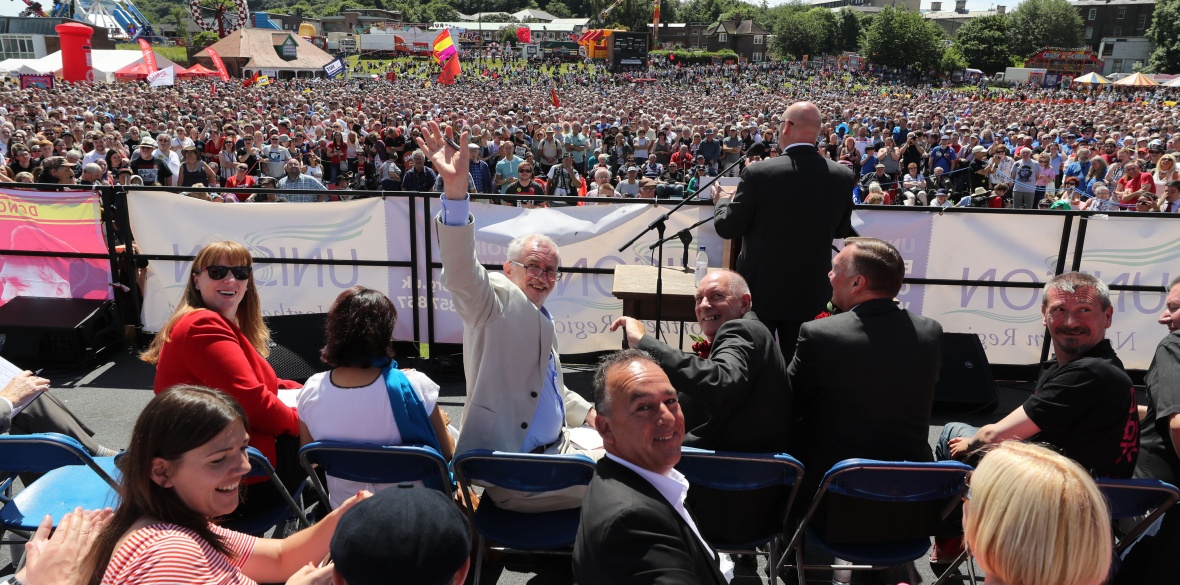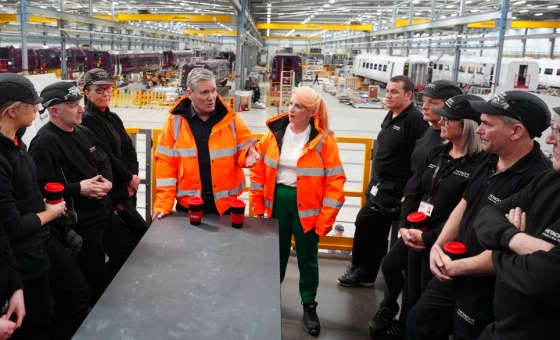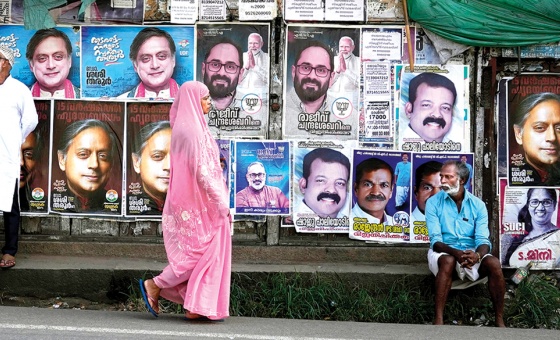This is the last article you can read this month
You can read more article this month
You can read more articles this month
Sorry your limit is up for this month
Reset on:
Please help support the Morning Star by subscribing here
THE Tory Party since Margaret Thatcher may have murdered the British coalmining industry but it never managed to kill the spirit and culture of our mining communities.
Nowhere is this better demonstrated than at the Durham Miners’ Gala — the Big Meeting held in Durham each July.
This year marks 150 years since the first Gala and this year’s event is the 135th Gala.
The Gala takes place today and an amazing panel of trade union and Labour leaders will be speaking at the event.
They include two key Labour MPs, shadow secretary of state for business, energy and industrial strategy Rebecca Long Bailey and shadow minister for labour Laura Pidcock. Shadow attorney general Shami Chakrabarti will also address the meeting.
Unite the Union general secretary Len McCluskey heads an impressive list of trade union leaders that also includes Unison general secretary Dave Prentis, Communication Workers Union general secretary Dave Ward, National Education Union joint general secretary Kevin Courtney and General Federation of Trade Unions general secretary Doug Nicholls.
It’s an impressive list but you can also expect some surprise and often very topical speakers.
If you have never been here are a few tips. Gala day often starts very early in the old colliery villages all around Durham.
If a village still has a band it will march though their own village behind the precious banner that has been taken down from its place of honour in the village miners’ welfare or club for today’s gala.
Visitors from further afield need to plan to arrive early. Parking is possible in the town but as the centre of Durham is closed to traffic from 7am a far better option is one of the three large park-and-ride car parks. Many groups, including some more distant bands and miners’ lodges, will arrive by coach.
As early as 8.30am, the march will be forming up in the city centre marketplace and filling the streets with bands and banners on its slow, noisy but colourful procession towards the city racecourse.
Other bands will start from the Miners’ Hall at Red Hill near the railway station and even more from the New Inn in the west of the city. You can expect over 85 bands and at least 100 banners on the march.
The first focal point of the gala is the County Hotel at Old Elvet where the various legs of the procession come together.
Here, union leaders, invited guests and local dignitaries greet the march from the hotel balcony and the bands pause to play their own special piece they have been rehearsing for months.
From the hotel the march is soon off again the short distance to the racecourse where there is a platform for the speakers.
The procession can take three or four hours to pass the County Hotel due to the huge numbers attending and the frequent pauses and band performances at the hotel.
The atmosphere is wonderful. It is a rare celebration of working-class solidarity in general and the rich traditions of the north-east miners and their unions in particular.
All along the route of the march you will find Morning Star distributors, official gala programme sellers and just about every other left-wing journal published in Britain today.
Volunteers to distribute the Morning Star are always welcome. Pick up some copies from the Royal County Hotel or drop in and say hello at the Morning Star stall on the riverside at the racecourse.
As the banners arrive all round the racecourse, they are carefully fixed to the fences creating a colourful tapestry, part art gallery and part museum of working-class history.
Look out for my favourite banner. It comes from the village of Chopwell, once known as “Little Moscow.” It’s a relatively new banner painted only a few years ago to replace a well-worn and battle-scarred older banner.
Red and glistening gold, this wonderful silk icon of working-class culture features Marx, Lenin and Keir Hardie.
Once you have studied all the banners and picked you own favourites, then down by the river are rows of stalls selling everything from political books, badges, stickers, postcards and magazines to a vast selection of fast, and not so fast, food and all kinds of drinks.
Rest assured both body and brain are well catered for at the Big Meeting.
There are fairground rides for children and for adults who haven’t grown up yet as well as exhibition marquees.
Traditionally the best tea and cakes and place for political argument is in the Durham Labour Party tea tent. Don’t expect anybody this year to be mentioning Boris Johnson without a well deserved expletive linked to his name.
By 1pm all the banners are in position and the platform party arrives for the chair to open the meeting. This year taking the chair is the new Durham Miners' Association (DMA) secretary Alan Mardghum.
After the speeches, four or five selected bands and banners march to the cathedral for the miners’ service.
God-fearing socialists, as well as atheists who enjoy a rousing hymn played by a brass band, report the service is an inspiration.
You might have already noticed by now many of the banners have biblical but still progressive themes. Daniel in the lion’s den was always popular.
Back on the racecourse, the banners are raised again as the various miners’ lodges decide it is time to head homewards.
The afternoon’s liquid refreshment is sometimes said to make the bands’ performance more exuberant, and the marching somewhat shaky.
Durham’s many pubs will echo with political argument, Brexit versus Remain is sure to feature but most will agree that what we really need is a general election. Old miners’ tales will go on until late into the night.
You might like to make a weekend of your visit to Durham, spending Saturday at the Big Meeting and Sunday at the Beamish Open Air Museum.
Beamish has close connections with the miners’ gala and its living displays add another dimension to the rich working-class history of north-east England.
This year Beamish is celebrating the largest single investment ever seen with a £10.9 million grant from the Heritage Lottery Fund for the Remaking Beamish project.
The centrepiece will be a reconstructed 1950s town. This summer will see the opening of the 1950s Welfare Hall, the first exhibit to open in the 1950s town.
For more information visit www.beamish.org.uk.











